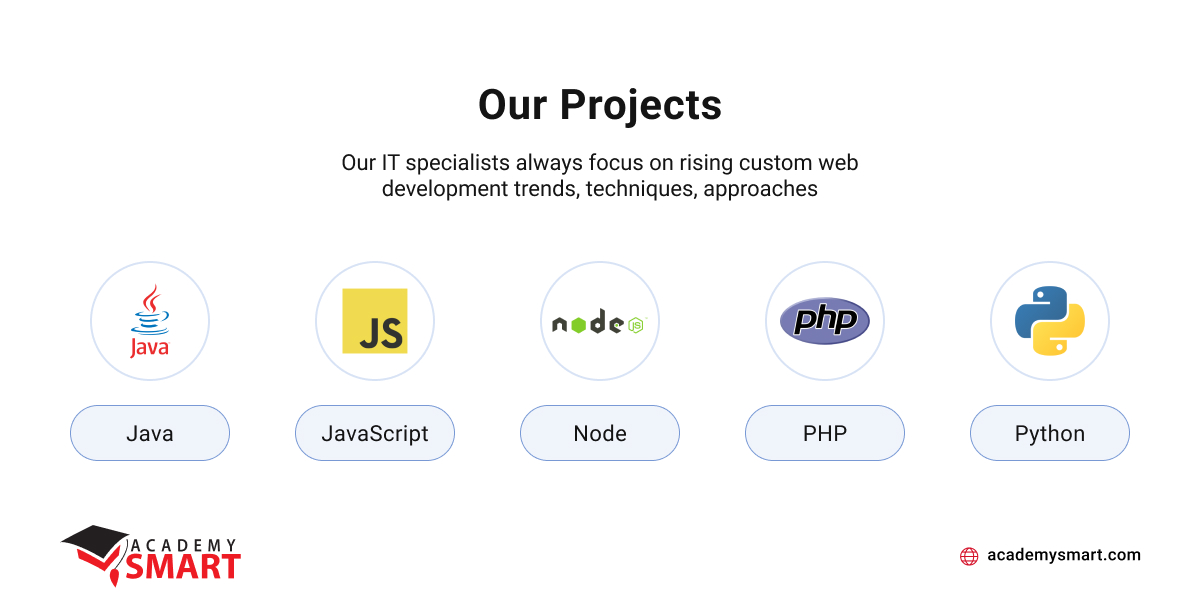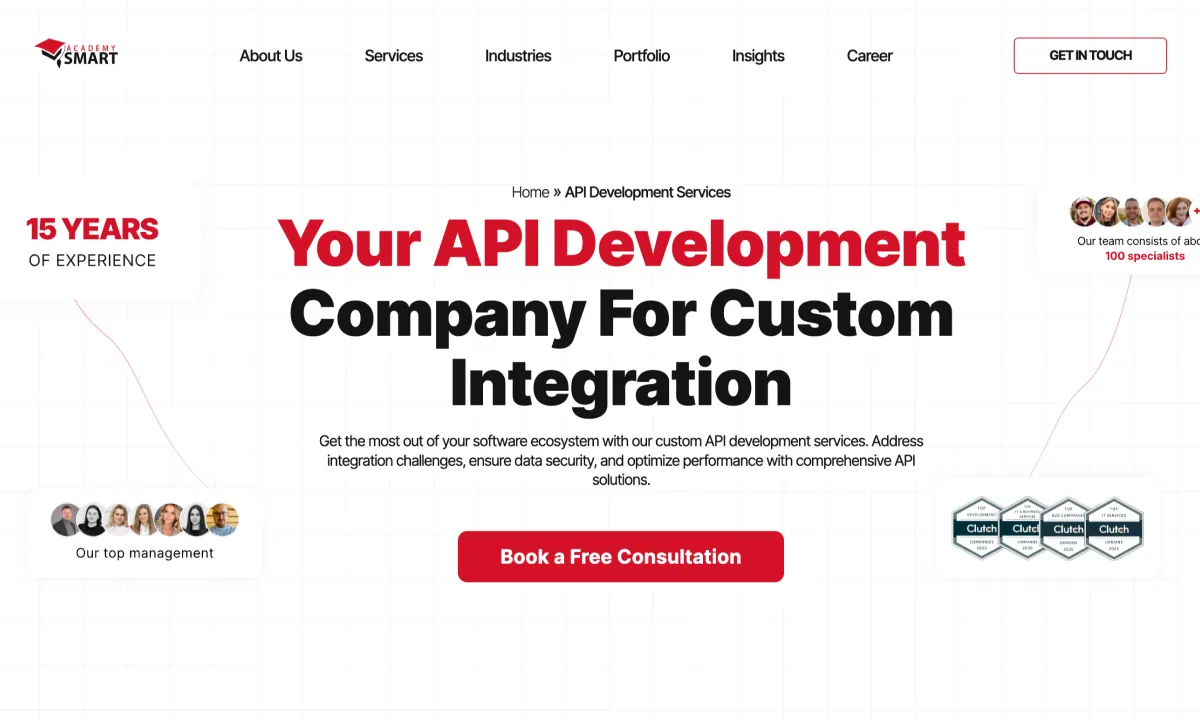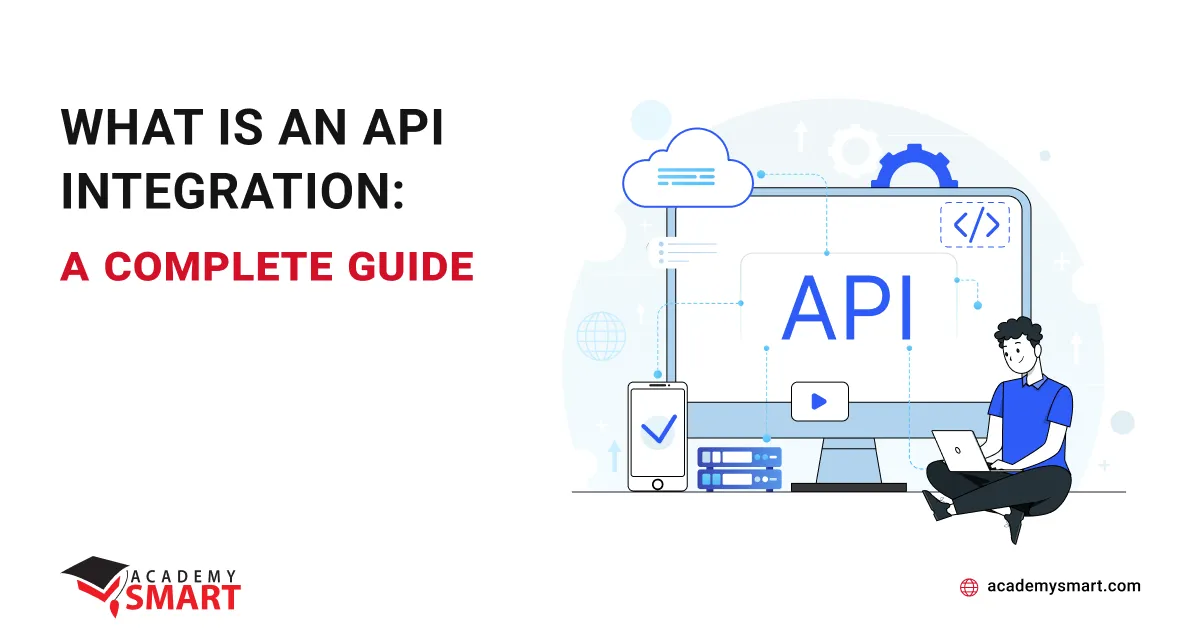
What is an API Integration: complete guide
Contents
Creating a modern software product does not always involve designing and writing its functions from scratch. Fortunately, the last decade of active digitalization of business processes and services makes it possible to effectively use various existing software solutions and combine them to solve new problems. This article focuses on API integration opportunities in software development and how it can help your business improve its software while avoiding large-scale expenses.
What is an API Integration
API integration is a wonderful software development life hack that allows you to quickly deploy complex information systems with relatively low costs for their creation.
Just think how profitable it is to link and synchronize the work of already existing, proven, and effective products without spending time and money on programming their counterparts. Indeed, with the help of APIs, you can create a multi-level and targeted routing of data from various existing sources, services, and applications to meet the business’s internal administrative objections and its customers’ needs.
So, what is an API integration? In the most common sense, it refers to connecting two or more separate software applications through their respective APIs, allowing them to communicate and share data expanding the range of useful functions of the developing software product.
The most common API integrations are custom ones created by developers based on the technical specification of a particular project, connector applications in a box, and cloud API integration platforms available on the market. Each type has its pros and cons; however, developing a custom one, as performed in the video presentation instances below, allows you to fully unlock the potential of the software product in achieving current business goals.
How do API Integrations work
Application programming interfaces are software intermediaries allowing different applications to talk to each other. On the one hand, the API is a tool that helps the servers fulfill the user’s requests. Still, on the other hand, it’s also responsible for translating those requests into formats the servers of commutated systems can understand and respond to with the relevant data.
Here is an example scenario, answering the question of how does API integration work:
- A user asks a primary application for data provided from another app.
- The first application requests the data from the second through API.
- The second application receives the request, authenticates it, and retrieves the appropriate data from the app’s database.
- The second application sends through the API the retrieved data back to the first one.
- The primary application receives the data, processes it, and displays it to the user.
This process happens in real-time. Therefore, to get a stable workflow, developers must ensure that the API integration is secure, reliable, and efficient.
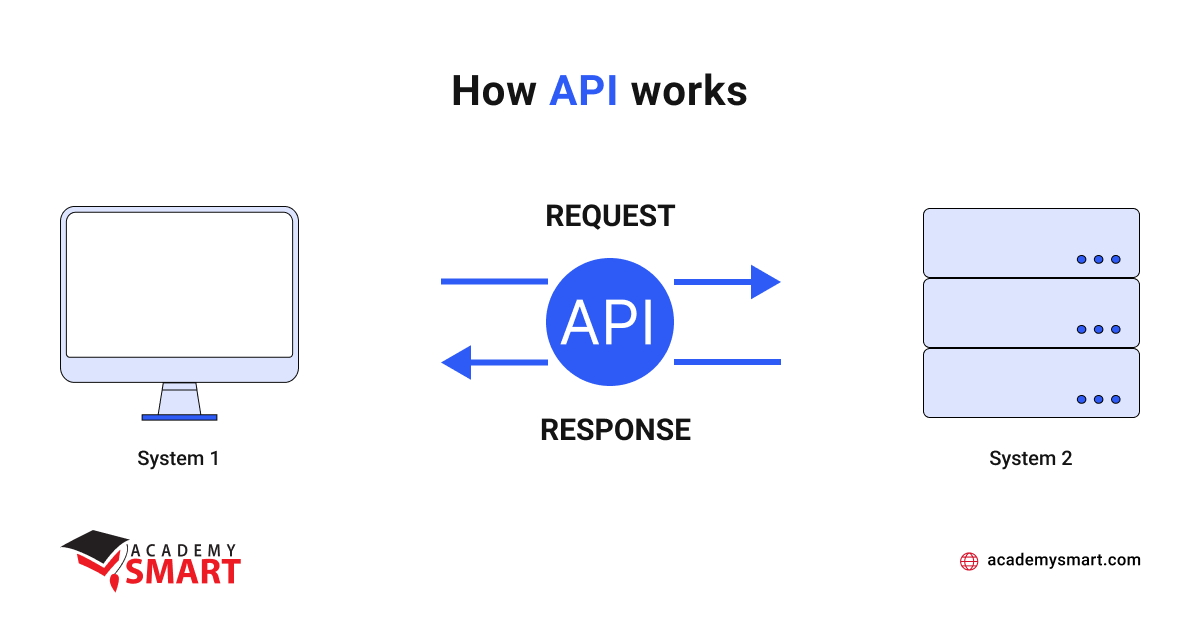
API work scheme
Why do you need API Integration
API integration is a universal solution for a wide variety of tasks that a business may face. Of course, its development has two main strategic goals: to increase profits through broader coverage, more satisfying customers, and faster interaction, and to reduce the costs of delivering the services and maintaining their proper quality.
The first goal is achieved by connecting your application with third-party, ready-made, and practical software, improving the user experience, and enriching the primary application with new and popular features. The second goal is realized in the economical usage of resources after the competent implementation of the API has been carried out.
What would you get with API integration in the most common cases?
- API integration allows for digitizing various business processes, resulting in cost savings through increased efficiency and automation.
- By centralizing information systems management through API connections, businesses can improve communication and decision-making while reducing operational complexity.
- The API data transferring can create additional value for a software product by enabling seamless integration with other platforms and improving user experience.
- The API can bridge the gap between applications that cannot interact with each other directly, allowing to leverage the benefits of multiple applications simultaneously.
- Legacy applications can be integrated with modern solutions through API integration, extending the lifespan and functionality of older systems while maintaining data consistency and security.
Naturally, each case of creating a high-quality enterprise application is unique and requires integrating software solutions specific to its industry.
- For online leisure, the ability to use game servers, video or audio hosting, and connection with social networks will be crucial.
- Integrations with document exchange, webinar and messaging online applications are ubiquitous for e-learning.
- Modern administrative, financial, and trading activities are impossible without tools that ensure the secure conduct of electronic transactions and the management of large arrays of sensitive data.
- Logistics companies will need switching systems for accounting for goods, warehouses, carriers, customer bases, and geolocation checking.
- Manufacturing and research companies usually require powerful computing possibilities and emergency warning systems.
You may see real examples of API integration our developers have worked with in our portfolio.
Benefits of API Integration
Undoubtedly, its main advantage is the absence of the need to develop one or another functionality each time. The ability to use ready-made solutions, and adapt them to the needs of your business, is an excellent opportunity to save substantial resources for developing a software product and bring it to market faster. However, in addition to the obvious strategic benefits, specific technical advantages lighten the weight of an enterprise application, significantly expanding its capabilities.
Data transfer automation
API integration often eliminates the need for manual data entry, saving time and reducing errors. With APIs assistance, data can be automatically transferred between applications, ensuring that information is always up-to-date and accurate. Additionally, automated data flow allows for more frequent updates, improving the overall quality of data and leading to better insights and outcomes.
Systems manageability
APIs provide real-time access to various data and ensure data accuracy and consistency, making managing and maintaining complex systems more straightforward. Considered API integration enhances end-to-end visibility of all systems and processes, leading to improved reporting and maintaining. So businesses can have a more comprehensive view of their operations and offer more variable services to their audience.
Communication stability
APIs provide a standardized and consistent way of server communication. It makes it easier to ensure data is transferred losslessly between systems, reducing the risk of errors and improving overall system reliability.
Load scalability
APIs can handle large amounts of traffic and requests from multiple sources simultaneously, allowing for greater flexibility in managing workload. It means businesses can handle large spikes in traffic without experiencing system downtime or slowdowns, ensuring a smooth user experience. Load balancing and caching can be implemented further to make the scalability and performance of the system better.
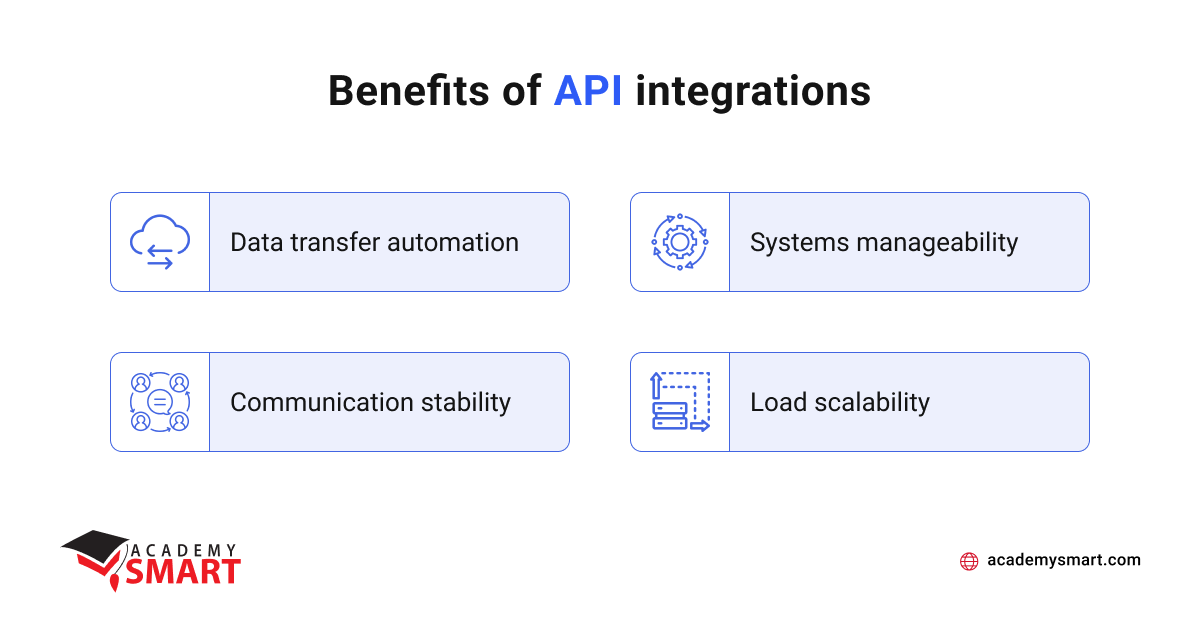
API integration benefits
5 examples of API Integration
Let’s explore some popular and impactful samples of API integrations used to solve business challenges and drive growth in various industries. Interested in learning more about which APIs our team sees as the most in-demand for enterprise applications right now? Get the detailed answer in the article “10 examples of APIs we use in 2023“.
1. Social media integrations
This software solution connects social networks like Facebook, Twitter, or Instagram to other applications or services. It lets users share content, login, or interact with social media data liking or posting content without leaving the primary application. Therefore, developers use the APIs provided by social media platforms to increase user engagement and enrich the product with demand features.
2. Payment gateway integrations
The payment gateway allows businesses to securely process and manage payments through their website or mobile app. It involves embedding a provider’s API into the business’s e-commerce platform for seamless transaction processing, secure payment data storage, and easy management of payment-related tasks such as refunds and chargebacks. These API integrations require high expertise in payment processing and security standards to ensure customer data is protected and transactions are executed correctly.
3. Cloud storage integrations
Cloud services give a variety of possibilities to primary applications through API connections, such as the ability to access and manipulate cloud-based data storage, utilize cloud-based computing power for complex tasks, and integrate with other cloud-based applications and services to create a more entire and interconnected environment.
Every day we interact with many cloud apps integrated with websites and mobile applications, watching videos on Youtube or sharing files using Google Drive, Dropbox, or OneDrive online storage. Not surprisingly, modern enterprise applications are complex and multi-level API integration examples that can combine dozens of cloud-based applications that perform specific tasks and features into a holistic system.
4. Marketing integrations
This example allows businesses to automate and streamline targeting processes by connecting marketing tools and platforms through APIs. It enables data to flow between different systems, providing a complete picture of customer behavior and helping businesses make more informed marketing decisions.
Instances of marketing API integrations include connecting Customer Relationship Management (CRM) software with email marketing platforms like Mailchimp, Campaign Monitor, Constant Contact, Sendinblue, and HubSpot, or social media advertising platforms like Facebook Ads, LinkedIn Ads, Snapchat Ads, and others.
5. Custom integrations
Custom API integrations are developed when existing options do not meet the specific requirements of an application. They may perform the following:
- Integration data from multiple sources.
- Building custom workflows.
- Automating business processes.
- Capability with legacy software products.
Customization of API integrations is challenging and requires strong expertise in developing and implementing APIs with different systems. However, it provides unique solutions that can be tailored to specific business needs.

API integration examples
How to build API Integrations
Building API integrations requires specific skills, including knowledge of programming languages like JavaScript, Python, or Java, certification methods, and data exchange protocols. The process itself usually involves:
- Exploring the API documentation;
- Authentication setting;
- Developing the integration solution;
- Testing and debugging;
- Further maintenance.
1. Exploration of the API documentation
API documentation is the foundation for any integration process because it outlines the available endpoints and methods for a given API. This description provides all the necessary information to understand the API’s structure, required authentication, general parameters, and expected responses.
Exploration of the API spec includes:
- reading the API documentation;
- analyzing the examples provided in the documentation;
- checking the data formats that are accepted and returned by the API;
- investigation of the available URLs that the API uses to access certain data or functionality and specific actions like retrieving, updating, or deleting data that can be performed there.
It should be reviewed thoroughly to understand the API’s purpose and how it fits into the project’s goals.
2. Authenticate with the APIs
Authentication is verifying the identity of the user or application making the API request to ensure that only authorized users or applications can access the API resources. This step is critical because APIs often provide access to sensitive data. Failure to properly authenticate with an API can result in unauthorized access to confidential data or other security breaches. That’s why developers follow the guidelines provided by the API provider to establish correct confirmation practices in the application when integrating a new API.
These guidelines typically include information on the type of proof required (such as OAuth, API keys, or tokens), how to generate and store certification credentials securely, and how to handle errors. Developers may also use authentication libraries or frameworks to simplify the verification process and reduce the risk of security vulnerabilities. Additionally, developers test the validation process thoroughly to ensure it works as expected and identify and address any potential security issues.
3. Build the integration solution
To build the integration solution, developers must first choose a programming language and development framework. They then write the code allowing the software to communicate with the API using the available endpoints and methods.
In many cases, developers create a basic prototype of the integration solution to test the functionality and identify potential issues. It can be helpful to catch any errors early in the development process and make adjustments as needed before proceeding with the full implementation of the integration.
During the development process, ensuring that the integration solution is robust and scalable and can handle large amounts of data and traffic is crucial.
4. Test the integration and handle errors
After the integration solution is built, the next step is to test it to ensure it works as expected. This process involves running various test cases to be sure the integration solution functions correctly in different scenarios. Developers must consider different data types and input values the API connection might encounter and possible error conditions.
During the testing phase, testing error handling is essential to ensure the solution can function in unexpected conditions and errors without crashing. Developers should also verify that error messages are informative and precise so that users can easily understand and resolve issues that arise.
5. Monitor and maintain the integration
When the API integration is accomplished, developers need to track its performance, such as processing requests within a specified time frame, handling a specific number of requests, or meeting other essential metrics. It’s also important to regularly review the API documentation for any changes or updates that may impact the integration.
If the API undergoes changes or updates, the integration may need to be updated to remain compatible with new requirements. Moreover, keeping the software up-to-date with the latest security patches and updates is crucial to ensure data security and protection from cyber threats.
In many cases, a large team of developers is not needed for further support, and an outstaffing back-end specialist is quite enough. However, complex information systems require the participation of different specialists. Therefore, the maintenance of API integrations for enterprise software is often performed by dedicated teams of outsourced experts. How to determine which of these options may be preferable in your case, the article “Outsourcing vs Outstaffing: What To Choose” may suggest.

Algorithm of API integrations building
How Academy SMART can help you
Our company has professionally developed complex software for enterprise companies for over 13 years. During this time, we have made more than 100 successful software deliveries that require a systematic approach to integrating various APIs in the vast majority of cases. Academy Smart carefully selects its server-side programmers, is proud of their achievements, and therefore guarantees the result of our work.
Using our services, you may get the following:
- a strong dedicated team of back-end developers to carry out the integration of a wide variety of application programming interfaces;
- highly qualified specialists in server technologies to augment your in-house crew;
- a complete project development team to build your software from scratch to final release.
If you need people who can add value to your IT product, contact us to find a better solution.
API Integration: Frequently Asked Questions
What is the difference between API and API integration?
API is a set of rules and protocols that define how software components should interact with each other. API integration, conversely, refers to connecting two or more APIs to enable them to exchange data and work together seamlessly.
How difficult is API Integration?
The difficulty depends on the complexity of the systems being integrated and the level of expertise of programmers responsible for the integration. While some integrations can be relatively straightforward, others can be challenging and require specialized knowledge and experience.
Book a free consultation

Reach out to start talking today!

